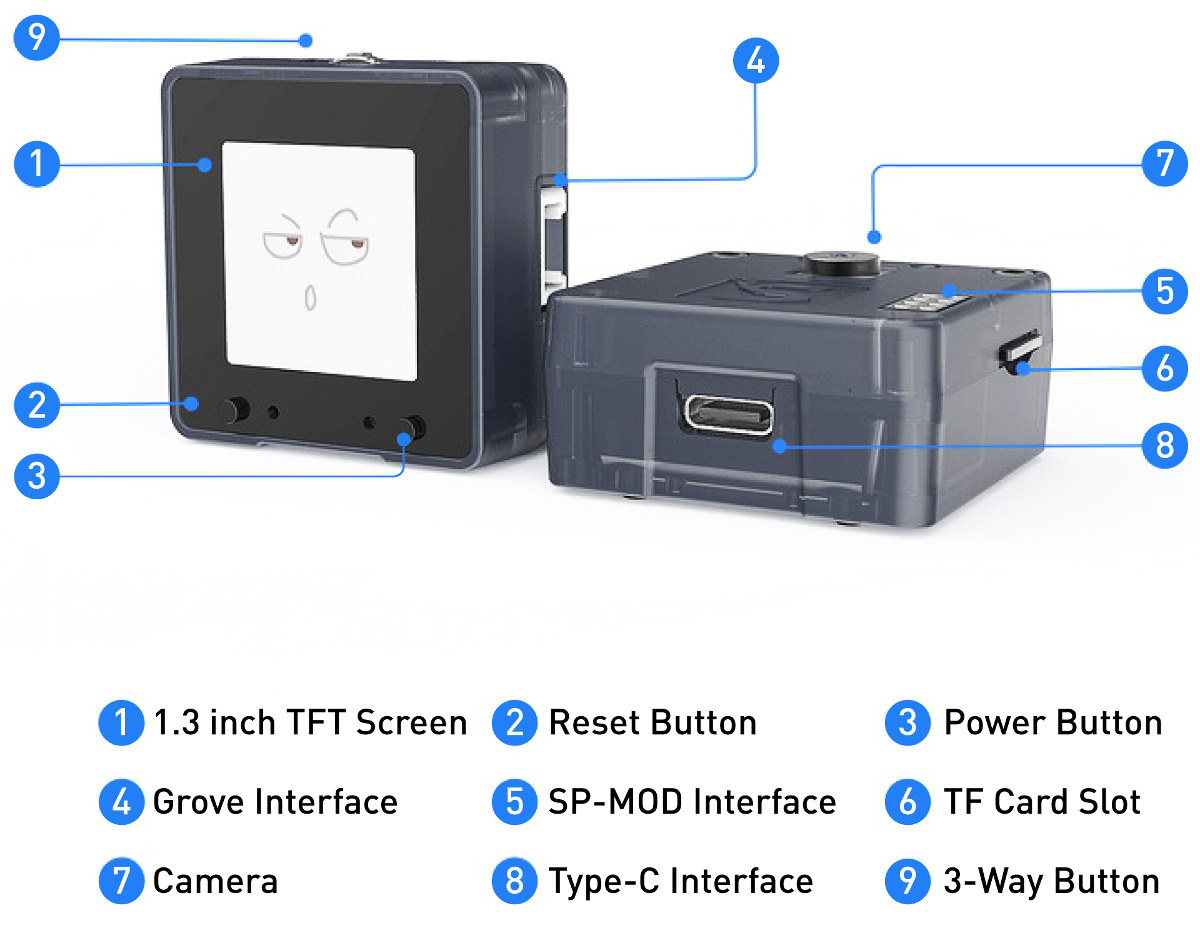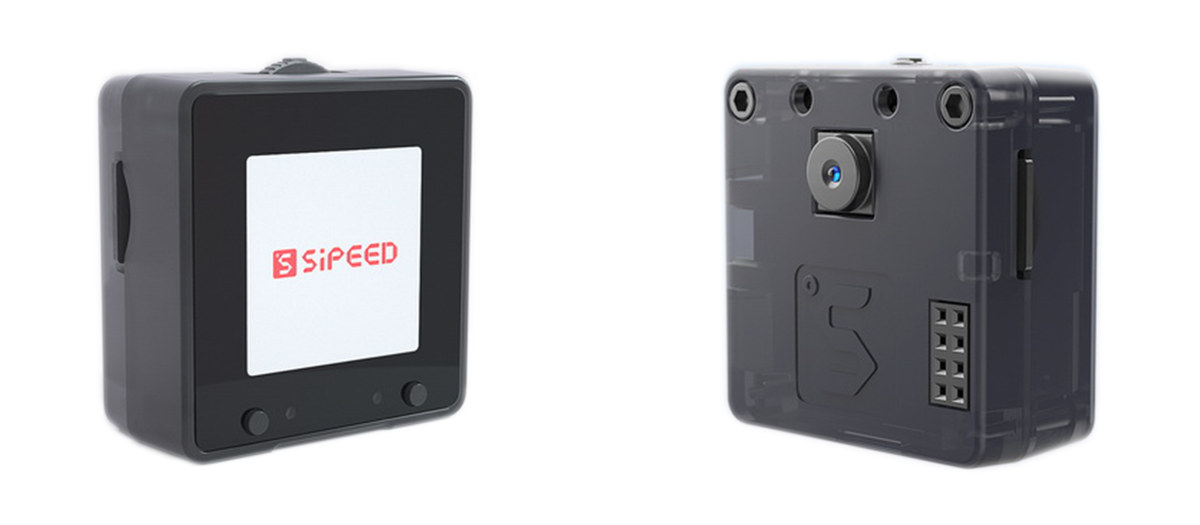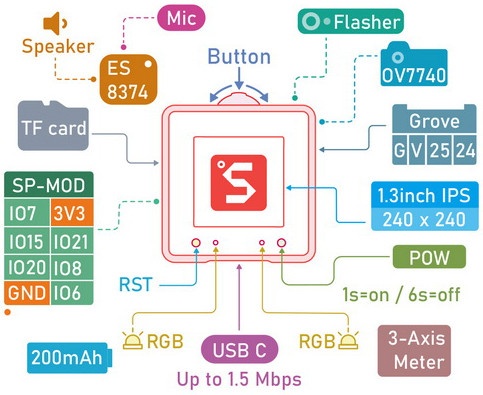Sipeed has made several boards and kits based on Kendryte K210 RISC-V processor for low-power AI workloads such as face detection or object recognition including Maixduino board and Grove AI HAT that ship with camera and display.
The company has now come up with MaixCube all-in-one development platform that houses Sipeed M1 module, a display, a camera, and a battery into a plastic case that’s somewhat similar to MStack M5StickV but with a larger display, and variations in the form factor and features.
Sipeed MaixCube specifications:
- SoC – Kendryte K210 dual-core 64-bit RISC-V processor @ 400 MHz (overclockable to 600 MHz) with FPU, 8MB SRAM, KPU AI accelerator, APU audio processor, and FFT accelerator
- Storage – 128 Mbit flash, MicroSD card slot
- Display – 1.3″ TFT screen with 240×240 resolution
- Camera – OV7740 sensor (VGA camera)
- Audio – Built-in microphone, external speakers support; ES8374 audio codec
- USB – 1x USB type-C interface
- Sensors – Accelerometer
- Expansion – 4-pin Grove interface, 8-pin SP-MOD interface
- Misc – Reset and power button, 3-way button, 2x RGB LED
- Battery – 200 mAh internal lithium battery
- Power supply – 5V via USB-Type-C port
- Dimensions – 40 x 40 x 16 mm

Just like other K210 platforms, MaixCube runs FreeRTOS or Linux although the latter is probably less useful since AFAIK AI accelerators have not been implemented in Linux. Development can be done with C/C++ (Arduino) or MicroPython in respectively PlatformIO/Arduino IDE or MaixPy IDE as we explain in our Sipeed M1 getting started guide.
Typical applications for the development kit include face detection, object recognition, FFT spectrum analysis, and game simulation. The system can perform image recording at 60 fps using QVGA resolution or 30 fps with VGA using YOLOv3, TinyYOLOv2, or face recognition demos and TensorFlow, Keras, Darknet or Caffe deep learning frameworks.
I had never heard about SP-MOD (SiPeed MODule) connector or modules previously. The 8-pin header features 6 GPIO as well as 3.3V and GND signal, and 14 different modules will soon be offers with a microphone array, multi SP-MOD adapter, PSRAM, Bluetooth, LoRa, E-Ink display and more…
Sipeed MaixCube is up for pre-order for $24.90 on Seeed Studio with shipping scheduled to start on May 8th.

Jean-Luc started CNX Software in 2010 as a part-time endeavor, before quitting his job as a software engineering manager, and starting to write daily news, and reviews full time later in 2011.
Support CNX Software! Donate via cryptocurrencies, become a Patron on Patreon, or purchase goods on Amazon or Aliexpress. We also use affiliate links in articles to earn commissions if you make a purchase after clicking on those links.







These ones are still missing WiFi to completely leverage their possibilities. I really like my M5StackV (that I bought after your post here) but ended up not using it because some of the project ideas I had required some remote access.
Regarding the SP-Mod, I noticed it already, I’ve seen some sort of baseboards onto which you can plug the module. You could for example attach them to the wall to deliver power and probably some I/Os and you just have to plug your module onto it to deliver the whole functionality. We could imagine this being provided by default on certain equipements (e.g. 3D printers or heat controllers) to support a simple optional UI for example.
If I remember correctly M5StackV has also a WiFi option, but maybe it was not available at the time of release.
Seeed Studio just replied about SP-MOD availability: “SP-MOD module, plan to release, the date is not sure yet.”
For the WiFi option they said it would be available but I don’t remember having seen it.
the SP-MOD is exactly the pin order of esp8266 module ESP-01s, and you can plug esp01s module to enable wifi.
we not integrate wifi because some country need extra wifi certification, so we use external esp-01s instead
I can understand these concerns. But then maybe you should have the ability to place the wifi module inside the enclosure so that it doesn’t leave external pins and components exposed and doesn’t represent a prominent part on a flat surface. Possibly that you could even support the PSF-B85 or ESP12F using a socket made of some soft pins that the modules would be inserted into. Just a few ideas.